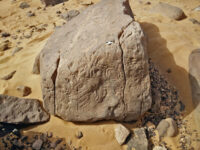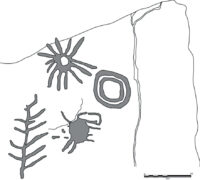An inscription on a rock from the late fourth millennium B.C. has been discovered to be the oldest known place name sign. The four hieroglyphs read “Domain of the Horus King Scorpion,” whose name was used in vain in several The Mummy spinoffs in the early oughts. The four symbols are a leafy plant, a scorpion, a solar disk and two concentric circles on the right. The circular hieroglyph is what marks it as a place name.
The inscribed rock was discovered two years ago in the Wadi Abu Subeira, the bed of an extinct river in the desert east of Aswan. The site is known for its profusion of Late Palaeolithic petroglyphs and is under constant threat from erosion and mining activities. Archaeological exploration of the location is still in comparative infancy. University of Bonn researchers led by Egyptologist Dr. Ludwig D. Morenz have been working with the Egyptian Ministry of Antiquities for several years to document ancient and prehistoric rock carvings.
There are very few sources about the political, social and economic conditions under which people lived more than five thousand years ago. “This is precisely why the new discovery of the rock inscription is so valuable,” says the Egyptologist. The very early use of the cultural practice of writing in this rather remote place is unusual for the fourth millennium B.C. Despite its brevity, the inscription opens a window into the world of the emergence of the Egyptian state and the culture associated with it. Morenz: “For the first time, the process of internal colonization in the Nile Valley becomes more visible by writing.”
According to the researcher, Egypt was the first territorial state worldwide. “There were already ruling systems elsewhere before, but these were much smaller,” says Morenz. It has been known for some time that the north-south extension of Egypt at that time was already around 800 kilometers. “In fact, several rival population centers merged into the new central state,” says Morenz. Royal estates, known as domains, were founded on the periphery of the empire in order to consolidate the pharaonic empire. […]
Various names of economic entities (domains) are already known from smaller text carriers such as labels for goods deliveries, cylinder seals and container labels. The rock inscription makes such a royal domain tangible as a concrete archaeological place for the first time. In addition to various rock carvings, other early rock inscriptions were discovered here and found together with pottery from this period. “This area is still in the early stages of archaeological investigation,” says Morenz. The researchers see this as an opportunity to take a closer look at the momentous process of the world’s first state emergence. This included the expansion and securing of the dominion at the edges in the Nile valley and the consolidation of the then new kind of kingship.


There are more impressions to the left of the carving. Perhaps the archeologists will discover more artifacts here.
What is the reference for the quoted passage?
@Jak, in the text there is a link to a post from the University of Bonn and that is where the referenced text is referring to, please note that it is also the only one.
As Winter solstice is here, Epiphanius of Salamis in Cyprus says in the fourth century that at Alexandria Aion’s birth from Kore the Virgin was celebrated 6 January, which in the Gregorian calendar that we use today is not totally accidentally the 24th of December: “On this day and at this hour the Virgin gave birth to Aion.” The date, which coincides with Epiphany, brought new year’s celebrations to a close, completing the cycle of time that Aion embodies. The Alexandrian Aion may be a form of Osiris-Dionysus, reborn annually.
🎅 ❄️ 🎁 ⛄ 🎄
In Paphos, the old capital, there is an ancient Roman holiday resort, and in the House of Aion (in the Paphos Archaeological Park) there is indeed a mosaic depicting the “Birth of Dionysos” that you might be familiar with, the difference is that the god Hermes has the newborn on his laptop:
————-
https://upload.wikimedia.org/wikipedia/commons/1/19/Paphos_Haus_des_Aion_-_Geburt_Dionysos_3.jpg
————-
You have a great blog.
However, it was hijacked and posted by Tango01 on The Miniatures Page.
http://theminiaturespage.com/boards/msg.mv?id=543099
This poster has been asked repeatedly by other bloggers and TMP members to list the name of the blog as a courtesy instead of just “link”. Please contact the owner of TMP, Bill Armintrout editor@theminiaturespage.com to assist in what many consider a juvenile disrespectful act.